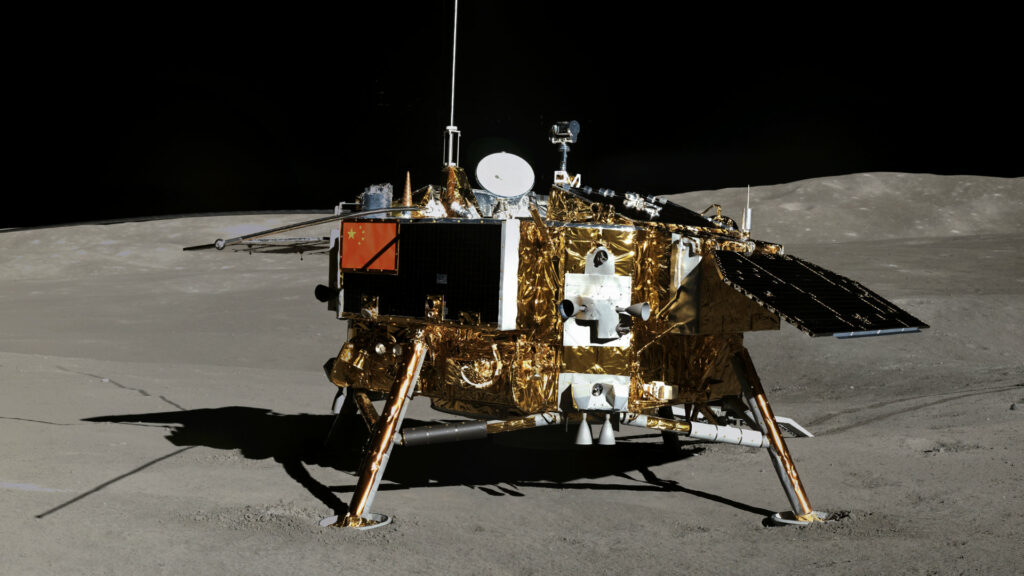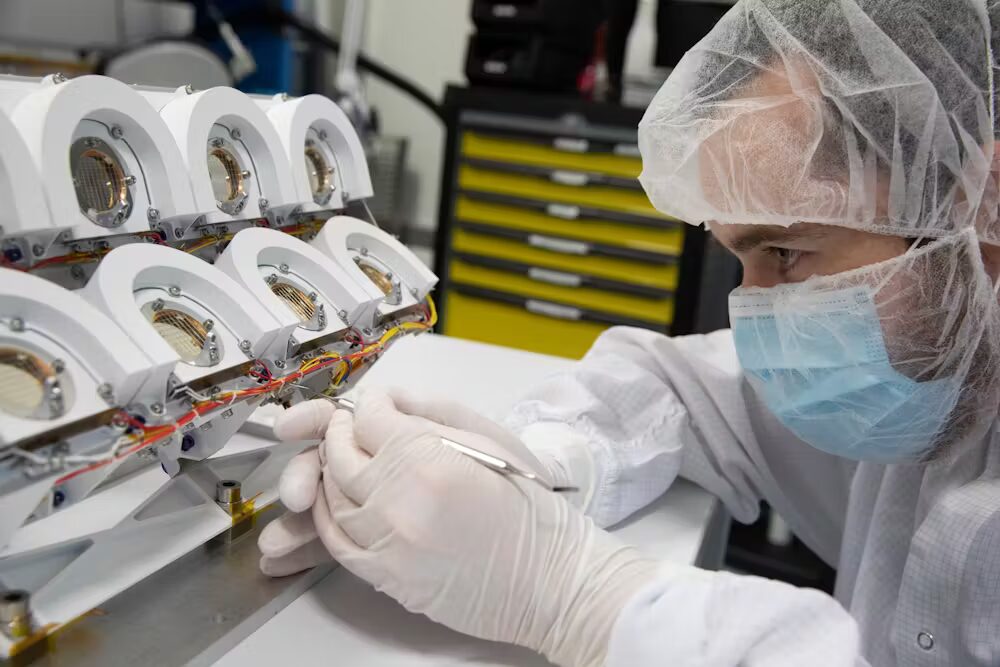A Chinese mission — Chang'e 6 — will bring a French instrument to the far side of the Moon. China hopes to be able to bring back samples, which would be a first on this side of the satellite.
China's lunar program is particularly ambitious if we consider that this country had not achieved anything in the field of deep space (beyond Earth's orbit) before the start of the 21st century.e century. Called Chang'e, named after the goddess of the Moon in Chinese mythology, it is divided into eight missions: the orbiters Chang’e 1 And 2 in 2007 and 2010, followed by two landers equipped with rovers with Chang’e 3 And 4 in 2013 and 2018, and by two lunar sample return missions, Chang'e 5 and 6, in 2020 and May 2024. The future plans Chang'e 7 in 2026 and Chang'e 8 in 2028, two heavy probes made up of several vehicles.
Advertisement
Chang'e 6 was built as a replica of Chang'e 5 and could have been used as a backup in the event of the latter's failure. But Chang'e 5, like all its predecessors, was a complete success in bringing back to Earth 1,731 g of lunar samples currently being analyzed. China gave a gift of 1.5g samples of this mission during President Macron's visit in April 2023 to Beijing.
After the 1er historic lunar landing on the far side of the Moon by Chang'e 4, and the success of Chang'e 5, China wants to go further and plans with Chang’e 6 1er return of samples from this same hidden side.

Indeed, the selected site is located within the large Aitken basin, also called SPA (South Pole Aitken Basin). The term basin (instead of crater) is important because it means that the asteroid which created this gigantic 2,500 km crater, one of the largest in the Solar System, pierced the crust and reached the mantle. lunar.
Therefore, Chang'e 6 aims to collect for the first time samples potentially from the mantle, but also ejecta from the lunar plateaus (crustal material), and basalts from the volcanism which took place on the far side. , 2.4 to 3.4 billion years ago, which should make it possible to better understand the overall composition of the Moon, to better understand the dichotomy between its visible side and its hidden side, and to improve the method dating planetary surfaces. More precisely, Chang'e 6 will land south of Apollo crater 490 km in diameter at 43° south and 154° west.
Advertisement
How will the moon landing of the Chang'e 6 mission take place?
To describe the scenario of this mission, I hypothesize that it is similar to the well-known one carried out by Chang'e 5. The 8.2 ton probe including 5.45 t of fuel, to carry out the numerous maneuvers required by a round-trip mission, must be launched on May 3 by a Chinese rocket from the base of Wenchang located on the island of Hainan, south of China.
The probe is injected on a direct trajectory towards the Moon. After four and a half days of cruise, it enters an elliptical orbit which passes 200 km from the Moon by the ignition of its main engine during its passage as close as possible to the Moon. During the following 1 to 3 weeks, Chang'e 6 will gradually circularize its orbit until it becomes circular at approximately 200 km altitude and inclined by 43° in order to pass above the chosen moon landing site.
The moon landing date is chosen according to various parameters including that of the local solar time when the probe will be on the ground. Indeed, on the Moon, as for the Apollo missions, the preferred local solar time is around 10-11 a.m. in order to have the shadows necessary to identify obstacles during the moon landing.


At the end of May or early June, the probe will separate into two vehicles: the orbiter and the lander. The latter lowers its perilune (point of the orbit closest to the surface) to 15 km, slightly higher than the highest lunar mountains (it is this maneuver that the Russian Luna 25 probe missed last August because, having braked too much, the perilune found itself at a negative altitude and the probe crashed before even starting its descent). From this “stone-free” orbit, the probe will again ignite its engine at the apolum and begin its ballistic descent (i.e. free fall) which will last around a quarter of an hour. The procedure is completely automatic.
The probe's computer compares the flight parameters with the theoretical ones it has in memory and adjusts its trajectory on this basis. Chang'e 6 probably does not have an ultra-precise lunar landing system like the Japanese SLIM probe which landed on January 18. SLIM took images of the surface and compared them with images in memory and corrected its trajectory accordingly. On the other hand, Chang'e 6 has an obstacle avoidance procedure on board. Arriving a few dozen meters from the surface, the probe stabilizes and takes images of the ground in order to identify dangerous obstacles or excessive slopes. The computer then determines the landing point and carries out the maneuvers to reach it. The difficulty with this procedure is that it creates a potentially dangerous horizontal travel speed with its engines and it is necessary to abort upon landing. We saw it recently, two probes landed on the side (SLIM And Odysseus), probably due to excessive horizontal speed.
What objective for the Chinese Chang'e 6 mission to the Moon?
Placed on the ground, Chang'e 6 must complete its mission in 48 hours, the time necessary for the operation. It will collect samples with its mechanical arm on the one hand (~1,500 g) and carry out drilling of up to 2 meters in order to recover samples at depth (~500 g). The Moon being devoid of atmosphere, it is constantly bombarded by various cosmic radiations of solar origin (solar wind, eruption) and galactic for the most energetic. The latter penetrate the ground up to one meter, hence the interest in collecting samples unaltered by this radiation. This procedure is carried out from Earth.
Chang'e 6 also carries four non-Chinese instruments: an Italian INRRI laser retro-reflector (to precisely determine the orbit of future lunar orbiters), a Swedish NILS instrument for measuring negative ions reflected by the surface, a Pakistani 6U cubesat iCUBE Q for the detection of traces of water and the French instrument DORN.
DORN (Detection of Outgassing Radon) is an alpha (or helium core) spectrometer made of silicon detectors which measures the radioactive decay of radon. It is under the scientific responsibility of Pierre-Yves Meslin of the Institute for Research in Astrophysics and Planetology in Toulouse who is the project manager under the project management of CNES. Radon is an inert rare gas resulting from the radioactive decay of uranium via radium. Radon is the ideal tracer of lunar degassing, it feeds the exosphere of the Moon which is an extremely tenuous dynamic atmosphere resulting from this degassing, but also from the solar wind and micro-meteoritic bombardment. Radon has already been detected around the Moon from orbit (Apollo 15 and 16, Lunar Prospector and Kaguya) but never from the surface, and with lower sensitivity than DORN.


Radon can be released from the lunar subsoil and diffuse or be transported by other gases to its surface (possibly following seismic events), where it will disintegrate and deposit its radioactive descendants, Polonium, on the surface. , which will also be measured.
Its disintegration and that of its descendants are accompanied by the emission of very energetic particles (alpha particles of a few million electron volts or MeV) which are detected by the DORN instrument. In summary DORN will study lunar degassing and the transport of gases in the regolith (and therefore constrain the thermophysical properties of the regolith which control them), their transport in the exosphere, the transport of regolith dust and go back to the content of uranium in the soil.
The samples collected by Chang'e 6 can also be analyzed in the laboratory and these analyzes can be compared to what DORN will have measured directly in the lunar environment. After half a century, DORN marks France's return to the surface of the Moon.
Chang'e 6's Return to Earth
After 48 hours on the Moon, the ascent module takes off with its precious samples and makes a rendezvous in lunar orbit with the orbiter, then the samples are transferred to a return capsule. The module is then released and the orbiter begins maneuvers to extend its orbit until injection on its return trajectory. Three days later, the capsule is released towards Earth. This re-enters at more than 11 km/sec and rebounds in the atmosphere, descending to 60 km and then rising to around 100-140 km. The landing takes place under a parachute in the banner of Siziwang in Inner Mongolia.
Note that on March 20, 2024, China sent the relay satellite into lunar orbit Queqiao 2. This one (1.2 tonnes) is a more efficient version of the Queqiao previous. This will be placed in an optimized orbit to ensure the relay function from the far side and the South Pole.
After Chang'e 6, China will target the South Pole with large moonlanders which are Chang’e 7 And 8. Beyond that, China announces that it wants to develop an automated research station at the South Pole (ILRS) open to international cooperation and which would ultimately be visitable by taikonauts. This program is very ambitious and is taking place so far with undeniable technological successes. At the same time, the Chinese manned program plans to send taikonauts on the Moon in the next decade.


Francis RocardPlanetologist, Responsible for Solar System exploration programs, National Center for Space Studies (CNES)
This article is republished from The Conversation under Creative Commons license. Read theoriginal article.
See the world from space
